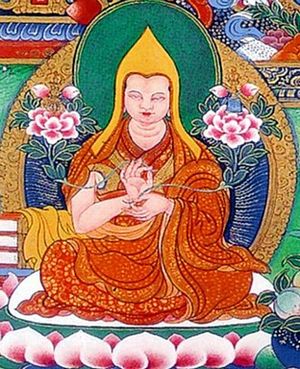Kangyur: Difference between revisions
Jump to navigation
Jump to search
No edit summary |
No edit summary |
||
| Line 1: | Line 1: | ||
[[Image:Buton.JPG|thumb|'''Butön Rinchen Drup''']] | [[Image:Buton.JPG|thumb|'''Butön Rinchen Drup''']] | ||
'''Kangyur''' ([[Wyl.]] ''bka' 'gyur'') literally the 'translated words' of the [[Buddha]] | '''Kangyur''' ([[Wyl.]] ''bka' 'gyur'') literally the 'translated words' of the [[Buddha]] — the Tibetan Buddhist canon is divided into the actual [[Word of the Buddha|words of the Buddha]] contained in the Kangyur, and the [[treatise]]s composed by the learned and accomplished masters of India, which are contained in the [[Tengyur]]. The compilation of the first version of the Kangyur was finalized by the great scholar [[Butön Rinchen Drup]] (1290-1364). Several versions of the compilation existed in Tibet, among which the most notable are those from [[Dergé Kangyur|Dergé]], [[Lhasa Kangyur|Lhasa]], [[Narthang Kangyur|Narthang]], [[Choné Kangyur|Choné]], Peking, [[Urga Kangyur|Urga]], Phudrak, and Tog Palace. | ||
==Divisions== | ==Divisions== | ||
| Line 13: | Line 13: | ||
*Paul Harrison, 'A Brief History of the Tibetan bKa' 'gyur' in Cabezón and Jackson, ed., ''Tibetan Literature: Studies in Genre'', Snow Lion, 1996 | *Paul Harrison, 'A Brief History of the Tibetan bKa' 'gyur' in Cabezón and Jackson, ed., ''Tibetan Literature: Studies in Genre'', Snow Lion, 1996 | ||
*Peter Skilling, ''Translating the Buddha's Words: Some Notes on the Kanjur Translation Project'', Nonthaburi, March 11, 2009 | *Peter Skilling, ''Translating the Buddha's Words: Some Notes on the Kanjur Translation Project'', Nonthaburi, March 11, 2009 | ||
==External Links== | |||
*[http://tbrc.org/kb/public.xq Open Access to Tibetan Canonical Works at the TBRC] | |||
[[Category:Kangyur]] | [[Category:Kangyur]] | ||
[[Category:Texts]] | [[Category:Texts]] | ||
[[Category:Key Terms]] | [[Category:Key Terms]] | ||
Revision as of 09:06, 20 May 2009

Kangyur (Wyl. bka' 'gyur) literally the 'translated words' of the Buddha — the Tibetan Buddhist canon is divided into the actual words of the Buddha contained in the Kangyur, and the treatises composed by the learned and accomplished masters of India, which are contained in the Tengyur. The compilation of the first version of the Kangyur was finalized by the great scholar Butön Rinchen Drup (1290-1364). Several versions of the compilation existed in Tibet, among which the most notable are those from Dergé, Lhasa, Narthang, Choné, Peking, Urga, Phudrak, and Tog Palace.
Divisions
- Vinaya ('dul ba)
- Prajñāpāramitā (sher phyin)
- Buddhāvataṃsaka (phal chen)
- Ratnakūṭa (dkon brtsegs)
- Sūtra (mdo)
- Tantra (rgyud)
Further Reading
- Paul Harrison, 'A Brief History of the Tibetan bKa' 'gyur' in Cabezón and Jackson, ed., Tibetan Literature: Studies in Genre, Snow Lion, 1996
- Peter Skilling, Translating the Buddha's Words: Some Notes on the Kanjur Translation Project, Nonthaburi, March 11, 2009